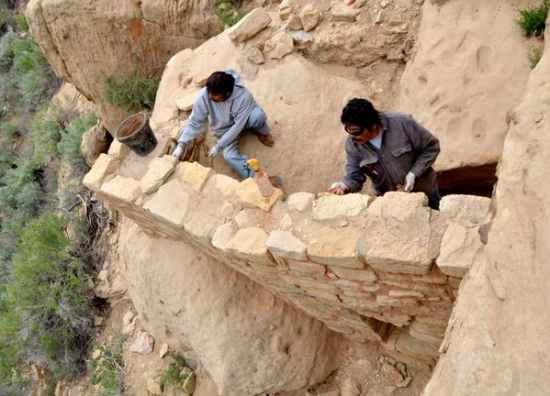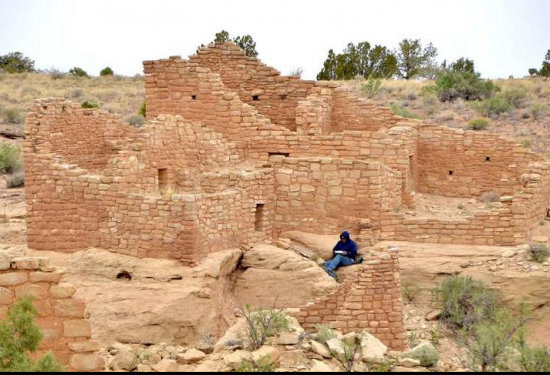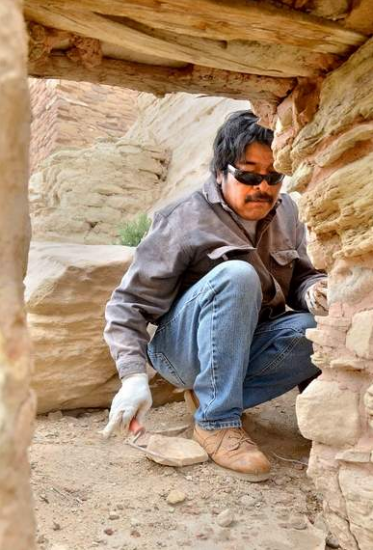Tobie Baker
Source - http://www.cortezjournal.com/article/20140504/NEWS01/140509931/Hopi-tribesmen-intervene-to-shore-up-Hovenweep-ruins-

Eloy Wytewa and Norman Albert stabilize a structure at Cajon Canyon. “Every site and situation is different,” says archaeologist Noreen Fritz.Sam Green/Cortez Journal photos
Utilizing an acrylic polymer mortar and tuck pointers, three Hopi stonemasons are stabilizing ancient ruins at Hovenweep National Monument.
“The work is important so future generations can enjoy these sites,” said Herschel Talashoma, foreman of the three-man stonemason crew.

Herschel Talashoma records information for photo documentation of the Cajon towers at Hovenweep. Sam Green/Cortez Journal photos
A direct descendant of the original inhabitants at Hovenweep, Talashoma said his grandfather introduced him to traditional stonework. Since 2009, he and fellow tribesmen Eloy Wytewa and Norman Albert, have worked on all the outlying sites at Hovenweep.
“There’s always a learning process to stabilization,” said National Park Service archaeologist Noreen Fritz. “The terrain, the weather, the exposure: every site and situation is different.”
The Hopi tribesmen are working at the monument’s Cajon Canyon site in southeast Utah, about an hour’s drive from Cortez. When The Cortez Journal visited last month, Talashoma was sitting with his back against a cliff-facing wall of the grand Cajon House compiling a photo annotation companion to match against previous restoration records.
“We all have different ideas about how to go about the work,” he said.

Norman Albert adds mud to stabilize the stones at the Cajon Canyon site.
Talashoma said relaying wishes to both his crew and federal officials were the most challenging aspects of the work, not the physical labor. He recalled explaining to National Park officials that using materials on site that matched fabrics used during original 13th century construction was especially challenging.
“Previously, stabilization crews would haul in sand from Cortez, and mix it with sand from other park locations,” Talashoma said. “It didn’t make any sense.”
Credentials born of the earth
After graduating high school, Talashoma’s first restoration project was working to rebuild a stone path to a village spring as a member of the Hopi Foundation. The organization’s archaeological preservation project helps to educate young Hopi members on conservation and documentation techniques for ancestral sites. Talashoma said they have helped preserve several 800-year-old village clan homes, and produced the tribe’s first technical guides for Hopi structural preservation.
“What I’ve learned here I’ve introduced to certain construction aspects back home, and vice versa,” Talashoma said.
An Arizona State graduate, Fritz embarked on her first archaeological expedition to Alaska at age 19. Fritz has worked in the Four Corners since 1990, and she was introduced to site preservation efforts as part of a post-fire archaeological project at Mesa Verde National Park in 1997. She’s also done similar repair work at Natural Bridges National Monument, Canyonlands National Park and Arches National Park.
“It’s an ongoing process,” Fritz said.
Preservation work continues
The latest round of restoration efforts at Hovenweep’s vanishing treasures were launched in 2009, when Fritz managed to secure funding through the American Reinvestment and Recovery Act. Guest user fees fund today’s repairs.
“The people who come to visit are helping us, and in return, we are helping them,” Fritz said. “It’s a nice little circle.”
Fritz added that renovation was needed to protect structures that were in immediate and imminent danger from natural erosive factors and cumulative pressures of visitation.
Preservation efforts at the national monument were first made in the 1940s. Starting in the 1960s, crews used concrete, a “double-edged sword,” Fritz said.
“The walls here are double-stone construction,” she said. “They have two veneers coming together. When they are capped with concrete, that actually keeps the water out, and keeps it from percolating down between the wall veneers.”
Because of the open-air sites at Cajon, Fritz said the National Park Service switched to native soils mixed with an acrylic polymer as mortar starting in the ’70s.
“We call it an acrylic mortified earth and mortar,” Fritz said. “It’s a lot more weather-able and lasts a lot longer.”
With balls of red clay in hand, Wytewa and Albert each squeezed dabs of mortar in between the Dakota sandstone bricks at Cajon. They used Marshalltown tuck pointers to push the mortar deep into the cracks before smoothing the joints. Small “chinking” stones were used sparingly, to level a large stone, for example.
“We try not to add a lot of chinking stones,” Fritz said. “That’s what has been done in the past, but we try to keep it as original as possible in appearance and construction.”
All the canyon head ruins at Hovenweep date to the Pueblo III time period. Most of the structures were built during the 1270s, and were concentrated around permanent water sources.
“We stabilize what we have,” Fritz said. “We don’t rebuild.”
After examining all legacy documents, condition assessments are conducted for all structures on-site, and recommendations are made as to specific restoration efforts.
“Then we just roll into treatment, which we call fabric intervention,” Fritz said. “It’s a fancy term for adding mortar in the joints.”
Hovenweep 101
A Ute word meaning “Deserted Valley,” Hovenweep was discovered by an expedition of Mormon colonists in 1854. Located nine miles from the monuments visitor’s center, the detached unit of the 40-acre Cajon Canyon Group is completely surrounded by the Navajo reservation with views of Monument Valley in the distance.
Built directly atop bedrock and situated around the head of a small canyon, remaining intact structures at Cajon are two- and three-stories high, indicating a large habitation site. White painted pictographs are located below the canyon rim.
Loopholes are present in many of the standing walls at Cajon, particularly in Cajon Castle. Archaeologists suspect these loopholes, or vantage points, allowed inhabitants to either monitor for predators or astronomical signs, or they simply served as ventilation portals.
Located at 5,200 feet above sea level, Cajon has been part of Hovenweep National Monument from the time of its inception in 1923, when President Warren G. Harding issued a proclamation to establish the monument.
The Cajon unit includes the remnants of a small hamlet of pueblos,.
Hovenweep structures represent the best preserved, protected, most visibly striking and accessible examples of 13th Century pueblo architecture and community locations in the San Juan River basin. Located across Southeast Utah and Southwest Colorado, a total of six detached units are contained in the monument.